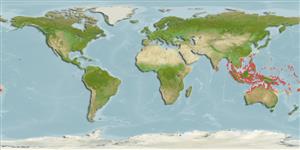Common names from other countries
分類 / Names
俗名 | 同種異名 | Catalog of Fishes(屬, 種) | ITIS | CoL | WoRMS | Cloffa
Teleostei >
Acanthuriformes (Surgeonfishes)
鱸形目 (Surgeonfishes) >
Siganidae (Rabbitfishes)
籃子魚科 (Rabbitfishes)
Etymology: Siganus: Latin, siganus = a fish, rabbit fish; by the similarity of the nose (Ref. 45335).
More on author: Valenciennes.
Environment: milieu / climate zone / depth range / distribution range
生態學
海洋; 半鹹淡水 礁區魚類; 深度上下限 0 - 20 m (Ref. 48637), usually 0 - 15 m (Ref. 90102). 熱帶; 19°C - 38°C (Ref. 1827); 30°N - 30°S, 77°E - 20°W
Indo-West Pacific: India, Sri Lanka, Andaman Islands, Thailand, Malaysia, Singapore, Indonesia, Philippines, Belau [=Palau], Guam, New Guinea, Solomon Islands, Fiji, Vanuatu, ?New Caledonia, ?Western Australia, ?Pohnpei, Caroline Islands, ?Ebon Island and Marshall Islands.
印度-西太平洋: 印度,斯里蘭卡,安達曼群島,泰國,馬來西亞,新加坡,印尼,菲律賓, 帛琉 [=帛琉] ,關島,新幾內亞,索羅門群島,斐濟,萬那度,?新加勒多尼亞,?西澳大利亞,?波納佩島,加羅林群島,?黑檀島與馬紹爾群島。
大小 / 重量 / 年齡
Maturity: Lm ? range ? - ? cm
Max length : 45.0 cm TL 雄魚/尚未辨別雌雄; (Ref. 1419); common length : 30.0 cm TL 雄魚/尚未辨別雌雄; (Ref. 9813); 最大體重: 2.4 kg (Ref. 125599)
背棘 (總數) : 13; 背的軟條 (總數) : 10; 臀棘: 7; 臀鰭軟條: 9; 脊椎骨: 13. Body bluish white; head brown to brownish or golden yellow with irregular blue lines. Preopercular angle 91°-102°; strong overlapping scales cover cheeks; midline of thorax scaled, not pelvic ridges. Anterior nostril with low flange, broadened slightly posteriorly. Spines stout, blunt or pungent, and venomous.
身體藍白色的; 頭部褐色到褐色或金黃色的有不規則的藍色線。 前鰓蓋骨角 91 °-102 °; 強的部分重疊的鱗片覆蓋頰; 胸的中線有鱗片而腹鰭脊則無了。 前鼻孔有些微地在後部被擴大的低的邊緣。 棘矮胖的﹐鈍的或尖銳的, 與有毒的。
Juveniles live among mangroves then move out to lagoon and coastal reefs as they mature. Forms schools. Feeds on algae growing on seagrasses, mangrove roots and rocks. Adults congregate inshore in groups of several hundreds to spawn in summer. Spawning is by pairs; sticky eggs laid on the bottom. Its very high quality flesh commands premium prices (Ref. 9813). Adults on coastal reefs, subject to strong currents (Ref. 48637). This species can tolerate very low salinities (2 ppt) and temperatures up to 38 C (Ref. 37816).
稚魚活的在紅樹林之中然後外移至潟湖與岸礁當他們成熟時。 形成魚群。 吃生長在海草,紅樹林根部與岩石上的藻類。 成魚聚集沿海地區數百隻成群產卵於夏天中。 產卵是逐對; 黏性卵產於了底部。 它的很高品質肉擁有高價。 (參考文獻 9813) 這種能容忍非常低的鹽度 (2個 ppt) 與溫度高達 38個 C 。 (參考文獻 37816)
Life cycle and mating behavior
Maturities | 繁殖 | Spawnings | Egg(s) | Fecundities | 仔魚
Throughout summer, adults form inshore breeding groups of several hundred individuals on the 7th or 8th days of the lunar month; pairs break from these groups to spawn. The species has a high fecundity of 350,000/spawning season. 印度-西太平洋: 印度,斯里蘭卡,安達曼群島,泰國,馬來西亞,新加坡,印尼,菲律賓, 帛琉 [=帛琉] ,關島,新幾內亞,索羅門群島,斐濟,萬那度,?新加勒多尼亞,?西澳大利亞,?波納佩島,加羅林群島,?黑檀島與馬紹爾群島。
Woodland, D.J., 1990. Revision of the fish family Siganidae with descriptions of two new species and comments on distribution and biology. Indo-Pac. Fish. (19):136 p. (Ref. 1419)
CITES (Ref. 128078)
Not Evaluated
人類使用
漁業: 商業性; 養殖: 將來有可能使用; 水族館: 商業性
工具
特別的報告
下載 XML
網路資源
Estimates based on models
Preferred temperature (Ref.
115969): 26.2 - 29.3, mean 28.6 (based on 2941 cells).
Phylogenetic diversity index (Ref.
82804): PD
50 = 0.5000 [Uniqueness, from 0.5 = low to 2.0 = high].
Bayesian length-weight: a=0.01230 (0.00669 - 0.02263), b=3.13 (2.97 - 3.29), in cm Total Length, based on LWR estimates for this species & Genus-body shape (Ref.
93245).
營養階層 (Ref.
69278): 2.0 ±0.00 se; based on food items.
回復力 (Ref.
120179): 中等的, 族群倍增時間最少 1.4 - 4.4年 (K=0.3).
Fishing Vulnerability (Ref.
59153): Low vulnerability (20 of 100).
